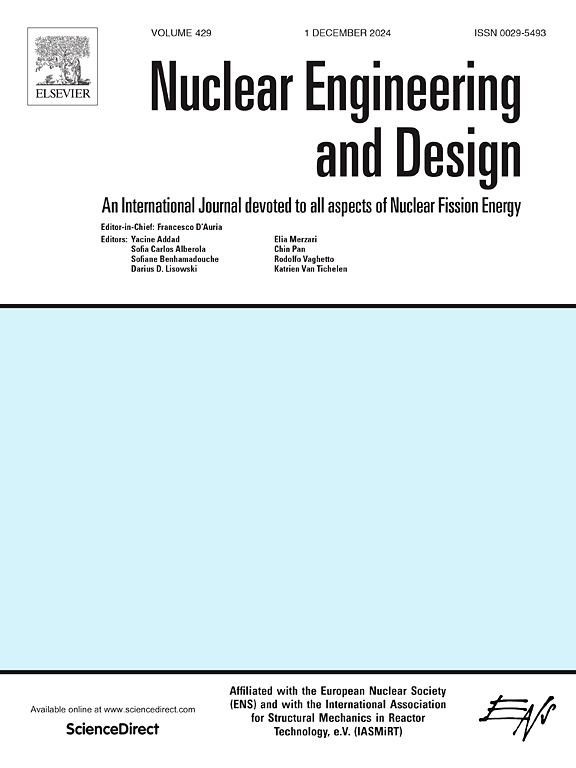横向载荷作用下粘接正交梯形蜂窝铝的动态力学性能
IF 1.9
3区 工程技术
Q1 NUCLEAR SCIENCE & TECHNOLOGY
引用次数: 0
摘要
为了保证核乏燃料运输桶在运输过程中的安全,在桶的两端安装了减震装置。这些装置充满了减震材料,用于在下落过程中消散能量。对于核设备来说,理想的减震材料具有双向或三轴减震性能。本研究研究了双向结构材料——键合正交梯形蜂窝铝(BOTHA)的动态力学性能(Y和Z方向具有相同的横截面形状;该材料具有简单的制造工艺、成本效益和两侧可比较的承重性能,从而使其能够更好地应对复杂的操作条件)。我们测试了三种不同的BOTHA材料,不同的细胞厚度与细胞尺寸比(0.3/2.5,0.4/2.5和0.5/2.5),沿着Y或Z轴(横向)不同的速度载荷(1.66 × 10 - 3/s, 47/s和290/s),以确定它们的变形和能量吸收特性。由实验结果得出的能量吸收图,可以快速分析冲击限位器在各种运行条件下的变形和能量吸收。根据动力本构律提取材料参数值。通过模拟,我们进一步探索了材料的变形和应力曲线特征,变形云图生动地说明了这一点。最后,我们通过比较BOTHA与传统木基填充材料的减震性能,评估了BOTHA作为核设备冲击限制材料的可行性。本文章由计算机程序翻译,如有差异,请以英文原文为准。
Dynamic mechanical properties of bonded-orthogonal trapezoidal honeycomb aluminum under lateral loading
In order to ensure the safety of nuclear spent fuel transportation casks during transit, shock absorption devices are installed at both ends of the cask. These devices are filled with shock-absorbing materials designed to dissipate energy during drops. For nuclear equipment, ideal shock-absorbing materials exhibit bidirectional or triaxial performance. This study investigates the dynamic mechanical properties of bonded orthogonal trapezoidal honeycomb aluminum (BOTHA), a bidirectional structural material (Y and Z directions have identical cross-sectional shapes;This material boasts a straightforward manufacturing process, cost-effectiveness, and comparable load-bearing performance on both sides, thereby equipping it to better address complex operational conditions.). We subjected three distinct BOTHA materials, differing in cell thickness −to-cell size ratios (0.3/2.5, 0.4/2.5, and 0.5/2.5), various velocity loads (1.66 × 10−3/s, 47/s and 290/s) along the Y or Z axis (lateral direction) to determine their deformation and energy absorption characteristics. The energy absorption diagram, derived from experimental results, allows for quick analysis of the deformation and energy absorption of the impact limiter under various operational conditions. Material parameter values were extracted according to the dynamic constitutive law. Through simulation, we further explored the material’s deformation and stress curve characteristics, vividly illustrated by the deformation cloud map. Finally, we assessed the feasibility of using BOTHA as an impact limiter material for nuclear equipment by comparing its shock absorption performance with traditional wood-based filling materials.
求助全文
通过发布文献求助,成功后即可免费获取论文全文。
去求助
来源期刊

Nuclear Engineering and Design
工程技术-核科学技术
CiteScore
3.40
自引率
11.80%
发文量
377
审稿时长
5 months
期刊介绍:
Nuclear Engineering and Design covers the wide range of disciplines involved in the engineering, design, safety and construction of nuclear fission reactors. The Editors welcome papers both on applied and innovative aspects and developments in nuclear science and technology.
Fundamentals of Reactor Design include:
• Thermal-Hydraulics and Core Physics
• Safety Analysis, Risk Assessment (PSA)
• Structural and Mechanical Engineering
• Materials Science
• Fuel Behavior and Design
• Structural Plant Design
• Engineering of Reactor Components
• Experiments
Aspects beyond fundamentals of Reactor Design covered:
• Accident Mitigation Measures
• Reactor Control Systems
• Licensing Issues
• Safeguard Engineering
• Economy of Plants
• Reprocessing / Waste Disposal
• Applications of Nuclear Energy
• Maintenance
• Decommissioning
Papers on new reactor ideas and developments (Generation IV reactors) such as inherently safe modular HTRs, High Performance LWRs/HWRs and LMFBs/GFR will be considered; Actinide Burners, Accelerator Driven Systems, Energy Amplifiers and other special designs of power and research reactors and their applications are also encouraged.
 求助内容:
求助内容: 应助结果提醒方式:
应助结果提醒方式:


